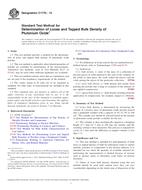We need your consent to use the individual data so that you can see information about your interests, among other things. Click "OK" to give your consent.
ASTM C1770-13
Standard Test Method for Determination of Loose and Tapped Bulk Density of Plutonium Oxide
STANDARD published on 1.1.2013
The information about the standard:
Designation standards: ASTM C1770-13
Note: WITHDRAWN
Publication date standards: 1.1.2013
SKU: NS-12394
The number of pages: 3
Approximate weight : 9 g (0.02 lbs)
Country: American technical standard
Category: Technical standards ASTM
The category - similar standards:
Annotation of standard text ASTM C1770-13 :
Keywords:
apparent density, nuclear materials, packed density, powder metallurgy, ICS Number Code 27.120.30 (Fissile materials and nuclear fuel technology)
Additional information
| Significance and Use | ||||||||||||||
|
5.1 This test method is intended for determination of bulk loose or tapped density or both for plutonium oxide or similar metallic powders or compounds in the nuclear industry. It is intended for use when the quantity of available material for performing the measurements is limited because of reasons such as nuclear safety or laboratory scale limits on nuclear inventory. 5.2 Values of loose bulk density obtained using this test method should be used with caution since they can vary considerably depending on the initial state of dispersion of the test specimen, height-to-diameter ratio of the specimen in the graduated cylinder, the dryness of the powder, and other factors. 5.3 The data from the tapped bulk density test can be used to estimate the needed volume of small containers holding a fixed mass of powder that has been compacted. 5.4 This test method may be useful for the determination of the Carr Compressibility Index as described in Test Method D6393. |
||||||||||||||
| 1. Scope | ||||||||||||||
|
1.1 This test method specifies a method for the determination of loose and tapped bulk density of plutonium oxide powder. 1.2 This test method is applicable when limited quantities of powder are available for performance of the measurements. Alternative test methods, such as Test Methods B527 or D7481, may be used when sufficient quantities are available. 1.3 This test method contains notes that are explanatory and are not part of the mandatory requirements of the method. 1.4 The values stated in SI units are to be regarded as standard. No other units of measurement are included in this standard. 1.5 This standard does not purport to address all of the safety concerns, if any, associated with its use. It is the responsibility of the user of this standard to establish appropriate safety and health practices and determine the applicability of regulatory limitations prior to use. Some specific hazards statements are given in Section 7 on Hazards. |
||||||||||||||
| 2. Referenced Documents | ||||||||||||||
|
Similar standards:
Historical
1.6.2011
Historical
1.1.2012
Historical
1.12.2008
Historical
1.6.2011
Historical
1.6.2009
Historical
1.6.2012
We recommend:
Technical standards updating
Do you want to make sure you use only the valid technical standards?
We can offer you a solution which will provide you a monthly overview concerning the updating of standards which you use.
Would you like to know more? Look at this page.



 ASTM C776-06(2011)..
ASTM C776-06(2011).. ASTM C784-05(2012)..
ASTM C784-05(2012).. ASTM C785-08
ASTM C785-08 ASTM C787-11
ASTM C787-11 ASTM C788-03(2009)..
ASTM C788-03(2009).. ASTM C791-12
ASTM C791-12
 Cookies
Cookies
